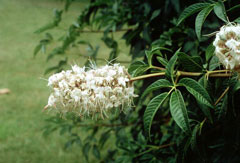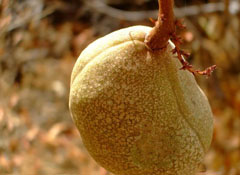 |
|
(c) ken Fern, Plants For A Future 2010 |
 |
| (c) Steve Flanagan |
Translate this page:
Summary
Bloom Color: Pink, White.
Main Bloom Time: Early spring, Late spring, Mid spring. Form: Rounded.
Physical Characteristics

 Aesculus californica is a deciduous Tree growing to 12 m (39ft) by 10 m (32ft) at a medium rate.
Aesculus californica is a deciduous Tree growing to 12 m (39ft) by 10 m (32ft) at a medium rate.
See above for USDA hardiness. It is hardy to UK zone 7 and is not frost tender. It is in flower from July to August, and the seeds ripen in September. The species is hermaphrodite (has both male and female organs) and is pollinated by Bees.
Suitable for: light (sandy), medium (loamy) and heavy (clay) soils and prefers well-drained soil. Suitable pH: mildly acid, neutral and basic (mildly alkaline) soils. It cannot grow in the shade. It prefers dry or moist soil.
UK Hardiness Map
US Hardiness Map
Synonyms
Pavia californica.
Plant Habitats
Woodland Garden Canopy; Secondary;
Edible Uses
Edible Parts: Seed
Edible Uses:
Seed - cooked[22, 46, 63, 92, 94, 95]. It can be dried, ground into a powder and used as a gruel[2]. The seed contains about 23% protein and has an agreeable taste[213]. The seed is large, and can be up to 5cm in diameter[82]. It is often produced abundantly in the warmer areas of Britain and is easily harvested[K]. This was the most commonly used Aesculus species in N. America[213]. It does, however, contain poisonous saponins (see the notes above on toxicity) and so needs careful preparation before being eaten. The seed needs to be leached of these toxins before it becomes safe to eat - the Indians would do this by slow-roasting the nuts (which would have rendered the saponins harmless) and then cutting them into thin slices, putting them into a cloth bag and rinsing them in a stream for 2 - 5 days[213]. Most of the minerals etc would also have been leached out by this treatment[K].
References More on Edible Uses
| Composition
|
| Figures in grams (g) or miligrams (mg) per 100g of food.
|
|
|
Seed (Fresh weight)
|
|
- 0 Calories per 100g
- Water : 0%
- Protein: 23g; Fat: 0g; Carbohydrate: 0g; Fibre: 0g; Ash: 0g;
- Minerals - Calcium: 0mg; Phosphorus: 0mg; Iron: 0mg; Magnesium: 0mg; Sodium: 0mg; Potassium: 0mg; Zinc: 0mg;
- Vitamins - A: 0mg; Thiamine (B1): 0mg; Riboflavin (B2): 0mg; Niacin: 0mg; B6: 0mg; C: 0mg;
- Reference: [ ]
- Notes:
|
|
Medicinal Uses
Plants For A Future can not take any responsibility for any adverse effects from the use of plants. Always seek advice from a professional before using a plant medicinally.
Expectorant Odontalgic Salve
The seed contains saponins and can be used as an expectorant[94]. The crushed fruit is applied as a salve on haemorrhoids[257]. A decoction of the bark is used in the treatment of toothache and loose teeth[257].
References More on Medicinal Uses
The Bookshop: Edible Plant Books
Our Latest books on Perennial Plants For Food Forests and Permaculture Gardens in paperback or digital formats.

Edible Tropical Plants
Food Forest Plants for Hotter Conditions: 250+ Plants For Tropical Food Forests & Permaculture Gardens.
More

Edible Temperate Plants
Plants for Your Food Forest: 500 Plants for Temperate Food Forests & Permaculture Gardens.
More

More Books
PFAF have eight books available in paperback and digital formats. Browse the shop for more information.
Shop Now
Other Uses
Friction sticks Soap Wood
The seed is rich in saponins, these are used as a soap substitute[169]. The saponins can be easily obtained by chopping the seed into small pieces and infusing them in hot water. This water can then be used for washing the body, clothes etc. Its main drawback is a lingering odour of horse chestnuts[K]. Wood - soft, light, very close grained[82]. Of no value as a lumber[229]. The wood was used as friction sticks for making fire by the North American Indians[257].
Special Uses
Scented Plants
References More on Other Uses
Cultivation details
Landscape Uses:Erosion control, Specimen. Prefers a deep loamy well-drained soil but is not too fussy[11]. Requires a position in full sun[200]. Prefers dry sunny locations[126]. Although fairly hardy throughout Britain, it grows best in areas where winter temperatures do not fall below -10°c[200]. A moderately fast-growing and long-lived tree in the wild[229], in Britain it grows best in eastern and south-eastern England. Plants thrives at Kew[11]. Most members of this genus transplant easily, even when fairly large[11]. Special Features:North American native, Flowers have an unpleasant odor, Blooms are very showy.
References Carbon Farming Information and Carbon Sequestration Information
Temperature Converter
Type a value in the Celsius field to convert the value to Fahrenheit:
Fahrenheit:
The PFAF Bookshop
Plants For A Future have a number of books available in paperback and digital form. Book titles include Edible Plants, Edible Perennials, Edible Trees,Edible Shrubs, Woodland Gardening, and Temperate Food Forest Plants. Our new book is Food Forest Plants For Hotter Conditions (Tropical and Sub-Tropical).
Shop Now
Plant Propagation
Seed - best sown outdoors or in a cold frame as soon as it is ripe[11, 80]. The seed germinates almost immediately and must be given protection from severe weather[130]. The seed has a very limited viability and must not be allowed to dry out. Stored seed should be soaked for 24 hours prior to sowing and even after this may still not be viable[80, 113]. It is best to sow the seed with its 'scar' downwards[130]. If sowing the seed in a cold frame, pot up the seedlings in early spring and plant them out into their permanent positions in the summer.
Other Names
If available other names are mentioned here
Native Range
NORTHERN AMERICA: United States (California)
Weed Potential
Right plant wrong place. We are currently updating this section.
Please note that a plant may be invasive in one area but may not in your area so it's worth checking.
Conservation Status
IUCN Red List of Threatened Plants Status :

Growth: S = slow M = medium F = fast. Soil: L = light (sandy) M = medium H = heavy (clay). pH: A = acid N = neutral B = basic (alkaline). Shade: F = full shade S = semi-shade N = no shade. Moisture: D = dry M = Moist We = wet Wa = water.
Now available:
Food Forest Plants for Mediterranean Conditions
350+ Perennial Plants For Mediterranean and Drier Food Forests and Permaculture Gardens.
[Paperback and eBook]
This is the third in Plants For A Future's series of plant guides for food forests tailored to
specific climate zones. Following volumes on temperate and tropical ecosystems, this book focuses
on species suited to Mediterranean conditions—regions with hot, dry summers and cool, wet winters,
often facing the added challenge of climate change.
Read More
Expert comment
Author
(Spach.)Nutt.
Botanical References
1171200
Links / References
For a list of references used on this page please go here
Readers comment